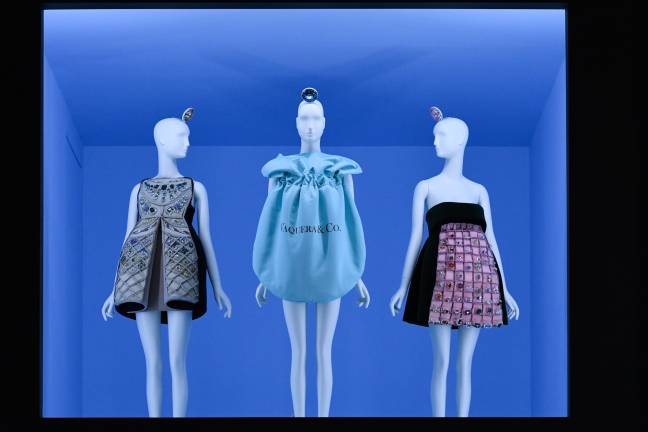The Word is ‘camp’

Who knew the term had so many meanings and layers? The first section of this ambitious show is devoted solely to contextualizing and defining the elusive word — “camp” as a verb, an adjective, a noun — with a soundtrack featuring Judy Garland singing camp anthem, “Over the Rainbow.”
Susan Sontag’s influential essay from 1964, “Notes on ‘Camp,’” a 58-point treatise on the subject, is the frame, the lens through which to view more than 250 paintings, sculptures, drawings, manuscripts, porcelains, photos and pushing-the-envelope fashions that give concrete form to the idea, the clothes especially.
Dethroning the Serious “Sontag gave us a grammar, a language by which to understand and to appreciate and to discuss [camp]. And in a way she’s the hero of the exhibition,” Andrew Bolton, Wendy Yu Curator in Charge of The Costume Institute, said at a preview last month.
Sontag’s defining principles are conveyed over speakers, illuminated on a ticker tape and appear as text on vitrines. Camp is extravagance (“a woman walking around in a dress made of three million feathers”), artifice and style. It’s kind, it’s generous, it’s fun. Note #41: “The whole point of Camp is to dethrone the serious.”
It’s ironic. It’s subversive. It’s democratic. It encompasses high-art, mass-culture and queer culture. It’s Versailles (“camp Eden”) — the theatricality of Louis XIV and his cross-dressing younger brother, “Monsieur” — and the 19th century dandy. Note #45: “Camp is the modern dandyism.”
Imagine Oscar Wilde, the “dandy-aesthete,” in a velvet jacket and waistcoat with satin trim (see Napoleon Sarony’s photos of the playwright posing in Aesthetic ensembles).
It’s Jazz Age flapper dresses, Josephine Baker and Tiffany lamps. Tiffany lamps? Note #8: “Camp is a vision of the world in terms of style — but a particular kind of style. It is the love of the exaggerated, the “off,” of things-being-what-they-are-not. The best example is in Art Nouveau, the most typical and fully developed Camp style. Art Nouveau objects, typically, convert one thing into something else: the lighting fixtures in the form of flowering plants, the living room which is really a grotto.” (See Tiffany Studios, “Tulip” Lamp, 1907-12.)
The Corner of a Circular RoomThe term is nothing if not elastic, and fantastic, so much so that a visitor can leave the show and not be certain she has it “down.” But, as fashion critic Vanessa Friedman suggests, it’s like the famous definition of pornography: you know it when you see it.
Bolton said the exhibit was much more challenging to produce than any of the previous shows at the Institute “mainly because camp is so difficult to define. It’s a huge, huge concept ... A cultural historian once said that trying to define camp is like sitting in a corner of a circular room. And it’s so true.”
It’s a sensibility that seems to find its clearest expression in fashion. The ensembles on view, by a string of haute designers, are presented in themed niches on two levels in the show’s second section, with labels like “Outrageous Aestheticism,” “Gender With Genitals,” “Gender Without Genitals” and “Rediscovery of History’s Waste.” Bring binoculars and look up!
“Rainbow” is piped in, along with recitations of Sontag’s criteria and other insights from the experts (“camperts”?), but it’s the designers themselves who give voice to the commentary. The experience is pure theater — “an echo chamber,” per Bolton — with the outfits competing with the aural effects for our attention.
Note Mark Booth’s aperçu from his 1983 book, “Camp,” alongside a Giambattista Valli evening dress in pink synthetic tulle: “The simple, bold colours of camp are ice-cream colours: camp’s favourite colour is pink: nursery pink, sugary pink, screaming pink.”
When asked about exhibit highlights, the curator singled out its intellectual underpinnings: “All the categories. I like the categories because the categories are based on particular comments [by] Susan or other scholars. What we tried to convey is that camp is really a site of debate rather than consensus.”
An Actual Freudian Slip What is not debatable is that the ensembles here are statements. They are cheeky, humorous, rebellious, hyper-male, hyper-female, androgynous and flat-out outlandish, fashioned from tulle, silk satin, sequins, suede, velvet, lace, leather and pink-and-black ostrich and coque feathers (the latter for a screaming-pink flamingo headpiece by Stephen Jones for House of Schiaparelli).
There’s a “Freudian slip” dress by Marc Jacobs — yes, an actual slip of a dress in silk jersey with Freud’s profile splashed across the front — because, as writer and artist Philip Core decreed in “Camp: The Lie That Tells the Truth” (1984), “CAMP is cross-dressing in a Freudian slip.”
Jeremy Scott from House of Moschino presents a jokey TV-dinner-themed ensemble, with peas and carrots, while Vaquera riffs the classic Tiffany jewelry pouch to create a wearable blue facsimile, because why not? It’s camp, and it’s comical.
Accessories are arranged in display cases at the center of the room. Philip Treacy’s “Smiley Face” headpiece in yellow acrylic is paired with Christopher Isherwood’s 1970 dictum, “Camp is happiness.”
Sounds like an inversion of the lyrics to the Peanuts song, “Happiness.” Look around at this exuberant show and it’s hard not to agree with him. Nailed it.